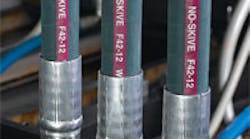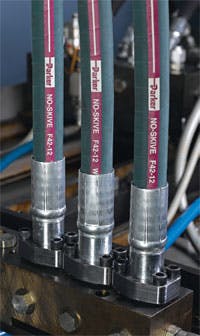The new Full Flange System from Parker Hannifin’s Hose Products Div., Wickliffe, Ohio, makes Code 61 and Code 62 hydraulic connections faster and easier to assemble thanks to a proprietary design that enables the flange to be attached to a hose after the fitting has been crimped on.
“Traditional full flange connections are held in place by flaring the tube and must be attached to the fitting before it’s crimped to the hose,” said Laura Elliott, of Parker’s Hose Products Div. “This new one-piece full flange connection is positioned on the fitting after it has been crimped, and is held in place by a highstrength stainless steel retaining ring. Once the flange engages the retaining ring, the flange is held securely in place, and this makes installation to the port a cinch because you’re not fumbling with two flange halves. Even bent tube installation is easier because the flange can freely rotate.”
The Full Flange System allows routing hoses through tight spaces, where assemblies with the flange end already attached would not fit. It can also be used repeatedly — because unlike captive flanges — the flange is not permanently locked onto the fitting.
Less inventory is another benefit of the new Full Flange System. Previously, two or three fittings were required for each different flange connection. Now, a single fitting — compatible with a Code 61 or Code 62 flange kit — is available. This eliminates one or two fittings for each port or hose size combination in stock. A wide selection of fittings is currently available, and more sizes will be added.
Parker’s Full Flange Kits include a seal, retaining ring, flange, and four Grade 8 socket head cap screws. All Full Flange Code 61 flanges are rated for pressure to 5000 psi, and all Full Flange Code 62 flanges are rated to 6000 psi. The Code 61 and Code 62 flanges meet SAE J1518 dimensional standards.
For a copy of Bulletin 4480-B145 describing the Full Flange System for Code 61 and Code 62 connections, contact Parker Catalog Services at 1-800-C-PARKER, or view it online at www.parkerhose.com.


